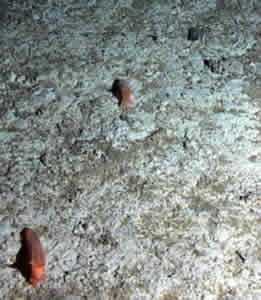
Sea cucumbers at Station M feed on dead algae (brown material on gray mud) that sank from the sunlit surface waters after a algal bloom. (c)2012 MBARI
Animals living on the abyssal plain, miles below the ocean surface, don't usually get much to eat. Their main source of food is "marine snow"â€"a slow drift of mucus, fecal pellets, and body partsâ€"that sinks down from the surface waters. However, researchers have long been puzzled by the fact that, over the long term, the steady fall of marine snow cannot account for all the food consumed by animals and microbes living in the sediment. A new paper by MBARI researcher Ken Smith and his colleagues shows that population booms of algae or animals near the sea surface can sometimes result in huge pulses of organic material sinking to the deep seafloor. In a few weeks, such deep-sea "feasts" can deliver as much food to deep-sea animals as would normally arrive over years or even decades of typical marine snow.
For over 20 years, Smith and his fellow researchers have studied animals living on the abyssal plain at Station Mâ€"a deep-sea research site about 220 kilometers (140 miles) off the Central California coast. The muddy seafloor at Station Mâ€"4,000 meters (13,100) feet below the surfaceâ€"is home to a variety of deep-sea animals, from sea cucumbers and sea urchins to grenadier fish. In addition, a myriad of smaller animals and microbes live buried within the mud.
Researchers have long wondered how all these animals and microbes get enough food to survive. The slow trickle of marine snow sinking down from above does not provide nearly enough food to support all the organisms that live down there. However, in a new paper in the Proceedings of the National Academy of Sciences, Smith and his coauthors show that occasional feasts could provide enough food to support deep-sea communities for years at a time.
Smith and his colleagues used several instruments to study the amount of marine snow arriving at Station M, as well as its impacts on life in the deep. They suspended conical "sediment traps" above the seafloor to collect and measure the amount of marine snow falling through the water. They also used automated camera systems to take time-lapse photographs of the seafloor. This allowed them to track the behavior, numbers, and sizes of larger deep-sea animals such as sea cucumbers. Finally, they used a seafloor-crawling robot, the Benthic Rover, to measure the amount of oxygen being consumed by animals and microbes in the sediment. Such oxygen measurements allowed the researchers to estimate how much food these organisms were consuming.
Using data from 1989 to 2012, Smith and his colleagues compared the amount of marine snow arriving at Station M with estimates of populations of microscopic algae observed at the surface using satellites. During most years, the amount of food arriving at the seafloor reached a yearly peak in summer and fall, but remained relatively low.
However, during 2011 and 2012, the researchers observed three dramatic events that delivered huge amounts of relatively fresh food to the deep seafloor. The first took place from June to August 2011, when large numbers of diatoms (a type of microscopic alga) bloomed near the surface, then sank rapidly to the seafloor.
The second event occurred from March to May 2012, when salpsâ€"gelatinous midwater animals that eat algaeâ€"reproduced rapidly in surface waters. These salps became so abundant that they blocked the seawater intake of the Diablo Canyon nuclear power plant, located on the California coast east of Station M. When the salps in the surface waters at Station M died, they sank so quickly that they carpeted the seafloor, four kilometers below. During the third event, in September 2012, another algal bloom created so much dead algae that it clogged the researchers' sediment traps, but was captured by a time-lapse camera.
The excess food that arrived on the seafloor during these feasts was not wasted. Instead, it was rapidly consumed by deep-sea animals and seafloor microbes, which used it to grow and reproduce. Some of the organic carbon from the food was released into the surrounding seawater by respiration. Most of the rest was incorporated into the deep-sea sediments, where it could be recycled by animals and microbes that feed on the mud. In this way, large, intermittent pulses of food could help sustain life in the deep for years or even decades.
Smith and his colleagues are still studying the biological effects of these extreme pulses of food. They have already seen changes in the numbers and types of deep-sea animals living at Station M that appear to result from the feasts of 2011 and 2012. They will be reporting these findings in a subsequent paper.
The researchers note that deep-sea feasts may be increasing in frequency off the Central California coast, as well as at some other deep-sea study sites around the world. Over the last decade, the waters off Central California have seen stronger winds, which bring more nutrients, such as nitrate, to the ocean surface. These nutrients act like fertilizer, triggering blooms of algae, which, in turn, sometimes feed blooms of salps. The fallout from all of this increased productivity eventually ends up on the seafloor.
The authors also note that the changes in ocean conditions that provided more food for deep-sea animals at Station M might be related to global warming. Alternatively, these changes could simply reflect naturally occurring long-term cycles in the ocean.
These findings remind us once again that the deep sea is directly affected by events at the ocean's surface, as well as human activities on land. In fact, information from deep-sea studies such as this will be essential to improving computer models of global carbon cycling and climate change.
